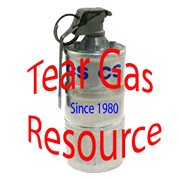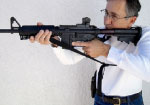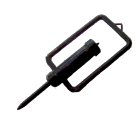Before we use Non-Lethal Chemical Agents on a barricaded suspect we must take many factors into consideration. Factors like:
- Types and qualities of agents we have available
- Contamination of the structure
- Cross contamination of the surrounding area
- Age and health of the suspect
- Suspect’s sobriety
- Our own units preparedness for using agent
- How much agent should we use (LCT50)
- How long should we wait before we enter a building to arrest the suspect
After thinking of all these factors and probably more we should prepare a gas plan. Along with the items listed above, when we prepare a gas plan we should always consider when the best time to deploy the Non-Lethal Chemical Agent is. The suspect’s biorhythms should be considered to establish that time.
Laugh you say, who cares about the suspect’s bio anything. After all we are going to arrest him. If we consider his biorhythms it might make our job easier and safer.
What is a biorhythm?
 A biorhythm is a cyclic pattern of alterations in physiology, emotions, and/or intellect. Simply, a biological rhythm is any cyclic change in the level of a bodily chemical or function. There has been much debate over the years about the validity of biorhythms as a whole. While most scientists and medical professionals agree that man’s physical and emotional states are always fluctuating, not all agree that they fluctuate in accordance with regular cycles that begin at birth.
A biorhythm is a cyclic pattern of alterations in physiology, emotions, and/or intellect. Simply, a biological rhythm is any cyclic change in the level of a bodily chemical or function. There has been much debate over the years about the validity of biorhythms as a whole. While most scientists and medical professionals agree that man’s physical and emotional states are always fluctuating, not all agree that they fluctuate in accordance with regular cycles that begin at birth.
But, there are numerous studies that support the principles of circadian biorhythms that we would probably deal with facing a barricaded suspect. Energy levels change each day in a natural biological rhythm with predictable high and low points. See a typical day’s biorhythms. The inclusion of drugs and alcohol may greatly enhance the biorhythmic change in a circadian cycle.
In a non-drug/alcohol induced day, low energy occurs at late afternoon and in the last part of the waking day. Related to this, feelings of moderate depression are often greatest in the evening. You are most vulnerable to tension in your lowest energy periods, and these are exactly the times when thoughts about yourself or the future are more negative. The best moods occur with heightened energy and reduced tension. The worst moods - depression, for example - occur with reduced energy and increased tension.
During a cycle another factor is stress. Stress is a person's response to a stressor such as an environmental condition or a stimulus. Being surrounded by the police is a definite stressor in most person’s lives. Stress is a body's method of reacting to a challenge. According to the stressful event, the body's way to respond to stress is by automatic nervous system activation which results in the fight-or-flight response. Stress typically describes a condition that can have an impact on a person's mental and physical well-being.
What you need to look for are signs of drug use, alcohol use, and stress as you attempt to predict what state of a cycle a suspect is in when you have him contained.
How Does This Help Us?
In order for a Non-Lethal Chemical Agent to work on a human being two factors mst be present. The first factor is the physical effects of the agent being used affecting the suspect. He must get the physical effects of the agent. Each agent reacts on the human body differently. However, these physical factors are not enough to make the agent work. The physical factors need to trigger a psychological response of panic. We want all those physical factors to give the suspect a feeling of panic. Panic to the point of flight. We want him to leave the area where he senses the danger coming from. We want him to flee the structure so we can arrest him. We must do all we can to maximize that psychological behavior.
There are many things that can cause a suspect to not get the psychological response we need. They range from drug and alcohol use to prior exposures to Non-Lethal Chemical Agents. All of these things are unpredictable. It doesn’t mean that if a suspect is high on drugs or alcohol Non-Lethal Chemical Agents won’t work. It means you need to consider these factors in your planning.
Do not let a suspect prepare mentally for your use of agent. Don’t telegraph your use or let your hostage negotiators use it as a bargaining chip. This preparation will lessen the chances of you being successful in your use. When the Non-Lethal Chemical Agent finally comes you want it to startle and surprise the suspect. He should feel like a two by four hit him in the face. You want him to panic and try and flee his environment.
In order to get the best response from the use of Non-Lethal Chemical Agents you should use it at a time that the suspect is most susceptible to the psychological response.
As an example, a typical meth user goes through at least seven phases of addictive behavior: (see stages of meth addiction)
- The Rush
- The High
- The Binge
- Tweaking
- Crash
- Hangover
- Withdrawal
Which stage of his drug use would garner the most favorable response for us?
During the Rush he may be in a state of heightened pulse and blood pressure for up to 30 minutes. Probably not the best time to add additional stimulus to his system. During his High state he is aggressive argumentative and delusional. If you inject chemical agent at that time it may just increase his behaviors. You don’t want him to be more aggressive. During the Binge, the suspect becomes hyperactive both mentally and physically. Again a state we don’t want to perpetuate. During his Tweaking stage he may be unable to sleep for days at a time, the suspect is often in a completely psychotic state and he exists in his own world, seeing and hearing things that no one else can perceive. His hallucinations are so vivid that they seem real and, disconnected from reality, he can become hostile and dangerous to himself and others. The potential for self-mutilation is high. The Crash happens when the body shuts down, unable to cope with the drug effects overwhelming it; this results in a long period of sleep for the person. Even the meanest, most violent suspect becomes almost lifeless during the crash. Along with the Hangover and Withdrawal stages it is an ideal time to stimulate him with Non-lethal Chemical Agents.
Every drug and alcohol high have their own stages of addictive behavior. You will get your best results using your Non-Lethal Chemical Agents when the suspect is in his low stages of his biorhythm and low phase of his addictive behavior.
Often referred to as the "body clock", the circadian rhythm is a 24-hour cycle that tells our bodies when to sleep and regulates many other physiological processes. This internal body clock is affected by environmental cues, like sunlight and temperature. When one's circadian rhythm is disrupted, sleeping and eating patterns can run amok. The circadian rhythm dips and rises at different times of the day, so adults' strongest sleep drive generally occurs between 2:00-4:00 am and in the afternoon between 1:00-3:00 p.m., although there is some variation depending on whether you are a “morning person” or “evening person.”
Bibliography
http://www.ce560xl.com/files/Biorhythm_Awareness.pdf
http://www.timeshighereducation.co.uk/news/biorhythms-and-blues/99250.article
http://www.livemint.com/Leisure/38p8RGtUoUXSmFguO4zYKO/Dancing-to-your-body8217s-biorhythms.html
http://www.drugfreeworld.org/drugfacts/crystalmeth/the-stages-of-the-meth-experience.html
http://www.matthewhooper.com/jedi-mindhacks-use-the-force-or-biorhythms/





